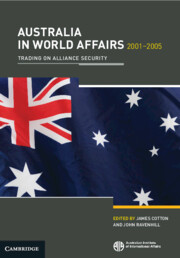500 results
11 - Commerce and Contracts
-
-
- Book:
- The Cambridge Comparative History of Ancient Law
- Published online:
- 09 May 2024
- Print publication:
- 30 May 2024, pp 565-597
-
- Chapter
- Export citation
2 - Extreme Allies: Australia and the USA
- from Part 2 - Relationships
-
-
- Book:
- Australia in World Affairs 2001–2005
- Published online:
- 04 May 2024, pp 19-44
-
- Chapter
- Export citation
10 - Australia and the Global Economy
- from Part 3 - Issues
-
-
- Book:
- Australia in World Affairs 2001–2005
- Published online:
- 04 May 2024, pp 163-179
-
- Chapter
- Export citation
1 - ‘Trading on Alliance Security’: Foreign Policy in the Post-11 September Era
- from Part 1 - The Foreign Policy Scene
-
-
- Book:
- Australia in World Affairs 2001–2005
- Published online:
- 04 May 2024, pp 3-16
-
- Chapter
- Export citation

Australia in World Affairs 2001–2005
- Trading on Alliance Security
-
- Published online:
- 04 May 2024
9 - Security, Defence, and Terrorism
- from Part 3 - Issues
-
-
- Book:
- Australia in World Affairs 2001–2005
- Published online:
- 04 May 2024, pp 147-162
-
- Chapter
- Export citation
3 - Rebuilding Engagement: Australia and South-East Asia
- from Part 2 - Relationships
-
-
- Book:
- Australia in World Affairs 2001–2005
- Published online:
- 04 May 2024, pp 45-60
-
- Chapter
- Export citation
7 - Australia and Europe
-
-
- Book:
- Australia in World Affairs 2006–2010
- Published online:
- 04 May 2024, pp 96-111
-
- Chapter
- Export citation
13 - Neither Entirely Comfortable nor Wholly Relaxed: Public Opinion, Electoral Politics, and Foreign Policy
- from Part 4 - Foreign Policy in the Political Process
-
-
- Book:
- Australia in World Affairs 2001–2005
- Published online:
- 04 May 2024, pp 215-260
-
- Chapter
- Export citation
6 - Peripheral Relations: Australia and Latin America
- from Part II - Relationships
-
-
- Book:
- Australia in World Affairs 1996–2000
- Published online:
- 04 May 2024, pp 65-76
-
- Chapter
- Export citation
9 - Australia and Japan
-
-
- Book:
- Australia in World Affairs 1991–1995
- Published online:
- 04 May 2024, pp 97-107
-
- Chapter
- Export citation
3 - The Rhetoric of Asia
-
-
- Book:
- Australia in World Affairs 1991–1995
- Published online:
- 04 May 2024, pp 23-32
-
- Chapter
- Export citation
7 - Australia and Fragile States in the Pacific
- from Part 2 - Relationships
-
-
- Book:
- Australia in World Affairs 2001–2005
- Published online:
- 04 May 2024, pp 111-127
-
- Chapter
- Export citation
14 - Parliament and Foreign Policy
- from Part 4 - Foreign Policy in the Political Process
-
-
- Book:
- Australia in World Affairs 2001–2005
- Published online:
- 04 May 2024, pp 261-280
-
- Chapter
- Export citation
7 - Australia and the World Economy 1991–95: Closer Economic Integration with Asia?
-
-
- Book:
- Australia in World Affairs 1991–1995
- Published online:
- 04 May 2024, pp 68-81
-
- Chapter
- Export citation
11 - Pragmatism, Prosperity, and Environmental Challenges in Australia’s Foreign Policy
- from Part 3 - Issues
-
-
- Book:
- Australia in World Affairs 2001–2005
- Published online:
- 04 May 2024, pp 180-193
-
- Chapter
- Export citation
4 - Australia–America 2006–2010: Waiting for Obama
-
-
- Book:
- Australia in World Affairs 2006–2010
- Published online:
- 04 May 2024, pp 46-61
-
- Chapter
- Export citation
3 - Balancing ‘Asia’ against Australian Values
- from Part I - Setting the Scene
-
-
- Book:
- Australia in World Affairs 1996–2000
- Published online:
- 04 May 2024, pp 23-36
-
- Chapter
- Export citation
5 - Australia and China: Towards a Strategic Partnership?
- from Part 2 - Relationships
-
-
- Book:
- Australia in World Affairs 2001–2005
- Published online:
- 04 May 2024, pp 76-94
-
- Chapter
- Export citation
15 - After the Flood: Foreign Policy and the Management of Intelligence
- from Part 4 - Foreign Policy in the Political Process
-
-
- Book:
- Australia in World Affairs 2001–2005
- Published online:
- 04 May 2024, pp 281-299
-
- Chapter
- Export citation



